We headed out of Seattle around noon and drove east, up and over the beautiful Cascade mountains. Once we dropped into the lower sagebrush country, we crossed the Columbia river on its way North to B.C. and continued nearly another 200 miles before arriving at Palouse Falls State Park. Just before we reached the park, however, we saw a big storm moving towards us from out of the southeast. On the front of the storm, there was this great wave. It was a dark brown cloud that stood out against the deep blue-gray of the thunderstorm. It moved swiftly in front of us and quickly covered the road as it moved West. It looked intimidating and I was uncertain whether driving through it was wise, so we pulled over. It was our first photo opportunity of the trip. We both jumped out and got buffeted by the storm winds. The brown wave was actually a dust storm that had been kicked up by the intense winds on the front of thunderstorm.
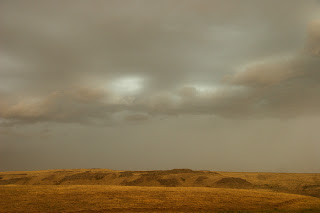
Storms can create an incredible interplay of light, shadow and color. It is difficult to capture the exact intensity of a storm on camera. There are somethings about being in a storm that can not be captured by words or images. The smell, the wind in your face, and the electric intensity in the air.
Both of us thought this was a dramatic start to our trip, and a perhaps positive omen hinting at the incredible things to come.
The dust storm passed us quickly and the road was was clear again, so we jumped in the car and headed to the campsite. Our base camp for the next few days would be Palouse Falls State Park. The thunderstorm ended literally as soon as we arrived in camp. As we set up our tent and started on dinner, the passing storm was lit up by the setting sun creating an amazing display of color over the shrub-steppe country above the rim of the Palouse falls canyon.
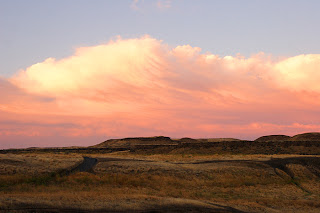 As the sun disappeared, the colors faded and the first stars started showing up in the deep blue of the evening sky. We finished our dinner of okra gumbo and catfish, and decided to try something new...
As the sun disappeared, the colors faded and the first stars started showing up in the deep blue of the evening sky. We finished our dinner of okra gumbo and catfish, and decided to try something new...That night, Phu and I tried our hand at astrophotography. This was a first for both of us, and it was a process of learning by trail and error. We walked out on a dirt trail away from the campground where our neighbors lantern was shinning brightly into the darkness of the night. When we walked up and over a small hill, we found the perfect spot to set up our tripods and start shooting pictures.
To explain how odd this was for both of us, let me give an example of what taking pictures is usually like. We walk up to a subject during the day and shoot, often at speeds between 1/100 to 1/1000 of a second. For the astrophotography, we set up the cameras and took photos that took 8 to 15 minutes! Shooting photos of stars was a patient activity. Waiting for 10 minutes for the camera to take a single photo, after pressing the shutter button is strange.
Our lack of experience with it created some rather funny moments. Initially, it was difficult for us to get a single photo to show any part of the landscape or part of the sky. They kept showing up black, as if no image was recorded. When we finally saw the sky and landscape show up on the LCD display, we celebrated with a cheer of "We have an image!" Both Phu and I are use to taking hundreds or sometimes thousands of frames in a matter of a week or two. So, it was rather hilarious for us to be so excited over a single image.
Once we figured out how to set up the shots, our success rate went up. As did the moon. Up to this point, the only hint of the moon had been a faint glow to the northeast. Once the moon was up, there was some concern that the stars would not show up in our photos. It is true, that they were somewhat less visible. Yet, it seemed that the presence of the moon mostly improved our shots.
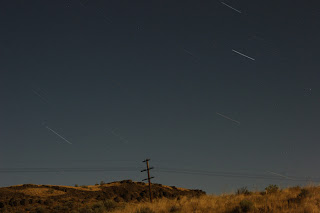
Our first astrophotography attempts, more specifically photos of stars were met with some success. To our utter surprise, we realized we could capture the movement of the stars in a matter of minutes. The frame on the left was shot in between 8 and 10 minutes of time. Already, you can see clearly the star trails showing the movement of the stars across the sky above the Palouse landscape. The light of the moon helped to illuminate the grassy ridge and telephone pole seen in the photo. Our night was over around midnight.
The following morning we got up bright an early, just before 6 am to take photos of the sunrise and the light it created on the canyon. The sunrise did not have the brilliant color display put on by the sunset of the evening before, but it created a great glow about the grasses and plants on the canyon rim. It also create extremely strong contrast of light and shadow within the canyon. This created a great sense of drama, and to me it was especially underlined in the way it isolated certain parts of the canyon relative to other ones.
There is a trail on the inside of the rim of the canyon, which only the brave and adventurous souls dare take on. It is very narrow and winding, with a very steep drop off on one side. The drop would be well over 200 feet to the canyon bottom below. The shadows framed this trail in
 an incredible way that to my eyes made it appear as if the trail was wandering along the edge of the world. Over the edge was a nameless, bottomless void which swallowed up any thing and anyone who might fall into its cavernous depths...
an incredible way that to my eyes made it appear as if the trail was wandering along the edge of the world. Over the edge was a nameless, bottomless void which swallowed up any thing and anyone who might fall into its cavernous depths...We spent over an hour photographing the light, the landscape and the sunrise. As our photo session came to an end before breakfast, I spotted one of the creatures that call this canyon home. It was a powerful bird of prey, and by its markings and begging calls I could tell it was a juvenile. This particular species of bird also happens to be the fastest bird in the word, clocked at well over 200 mph in a dive...
It was a peregrine falcon! This particular juvenile bird actually flew out of the canyon, and landed relatively close to us as we were walking back to our campsite. It perched on the rim of the canyon, and I was so thrilled to get to see one so close and it stayed in the same spot for over 10 minutes! I shot around 85 frames of this bird, as it looked around at things, preened, stared at me and as it begged its parents who flew around down in the canyon below to bring it some breakfast.
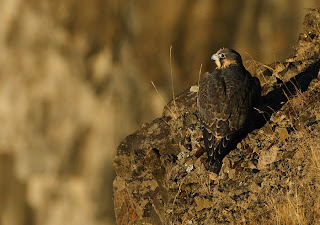
I don't think I can easily express the joy and honor I feel at getting to share space with such a magnificent creature. This is an animal of incredible grace, speed and power in flight which has no peer in the animal kingdom. It is a predator not only of the wild canyons of the West, but also the urban canyons found in between and on top of the great urban skyscrapers in our major cities. Though most people who live in big cities don't see them nor much evidence of them, except perhaps the occasional pile of pigeon feathers in a city park or back lot that these bird-eating predators leave behind.
To think, we almost lost this species not so long ago when DDT was used widely as a insecticide in the United States. The chemicals created havoc in the reproductive systems of the birds, affecting their eggs. When the eggs were laid, they would quickly develop cracks due to their shells being too thin. This made falcon numbers plummet and cause a huge mortality rate: virtually none of the chicks survived in the wild. It was only delisted from Endangered status on the Endangered Species List in August of 1999.
I told my friend Phu that if I did not get a chance to take photos of any more wild life on this trip, I would be satisfied because the falcon encounter was so special to me.
The falcon eventually flew down into the canyon to join its parents.
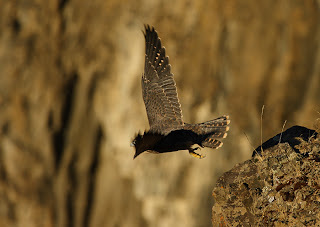
At this point, we were also thinking about our stomaches. Once back at base camp, we sat down to eat some bacon and warm oatmeal for breakfast. Then, we packed up our gear and headed out for a drive to seek out some very different landscapes from the canyon, but ones which are also very much a part of the Palouse region.
More on that in the next installment...